|
|
ADDRESS AT THE 19TH IB CENTENARY ENDOWMENT LECTURE
22-12-2006 : New Delhi
?Dynamics of Intelligence Missions?
?When evil minds combine,
Good minds have to work together and combat?.
I am delighted to deliver the 19th IB Centenary Endowment Lecture. I congratulate the IB community both present and past who have built a robust institutional framework for Indian intelligence system especially in the post-independent India. I extend my greetings to all the intelligence personnel, members of the central police forces, intelligence planners, administrators and young police probationers.

Origin of Intelligence Bureau in India
I understand that nearly 119 years back on this day, the British set up the Central Special Branch in India. This later became Criminal Intelligence Bureau and subsequently it got its present name of Intelligence Bureau (IB). The IB Centenary Endowment Lecture was started to provide the IB Personnel an opportunity to listen to speakers from various walks of life on some of the contemporary issues facing the country that may affect the way by which the IB carries out its functions. I was one of the speakers in my previous assignment as the DRDO Scientist. At that time, I chose to talk on the missile capability of the nation since I was deeply involved in that programme. Since then the world dynamics and the world order have changed. India has become a nuclear weapon State and its economy is growing due to the liberalization decision taken by the Government.
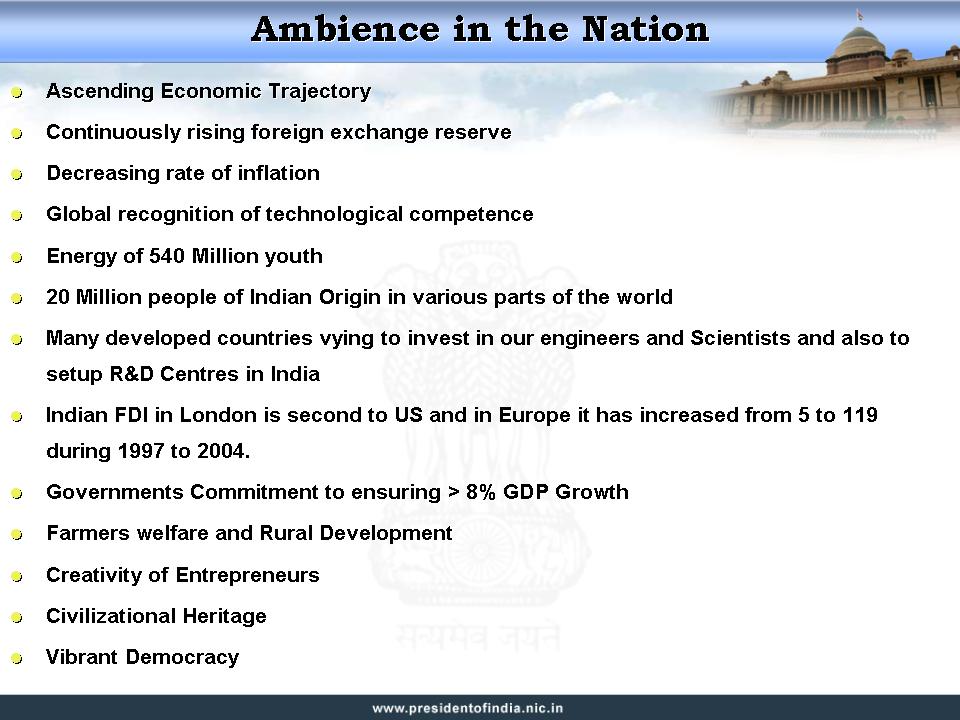

Ambience in the Nation 2006
In the Indian history, very rarely our nation has come across a situation, all at a time, an ascending economic trajectory, continuously rising foreign exchange reserve, reduced rate of inflation, global recognition of the technological competence, energy of 540 million youth, umbilical connectivities of 20 million people of Indian origin in various parts of the planet, and the interest shown by many developed countries to invest in our engineers and scientists including setting up of new R&D centers. The distinction between the public and the private sectors and the illusory primacy of one over the other is vanishing. India as the largest democracy in the world has a reputation for its democracy and for providing leadership for the one billion people with multi-cultural, multi-language and multi-religious backgrounds. And also our technological competence and value systems with Civilizational heritage are highly respected. Also, FIIs find investing in India attractive. Indians are also investing abroad and opening new business ventures. The Government is also committed to economic development by ensuring growth rate of nearly 10% annually, enhancing the welfare of the farmers and workers and unleashing the creativity of the entrepreneurs, business persons, scientists, engineers and other productive forces of the society. Today there is hardly any difference between AC II tier fare and Air fare if you are in a position to book in advance. Tele-density in the country has gone up to 18%. Railways have introduced super fast trains like Shatabdi express and people can book tickets through internet and railways are running in profit now. Our ICT sector is exporting nearly $ 24 billion and the Indian Pharma industry is ranked 4th in the world and exports nearly $ 4 billion of products. Our total export in the last 8 months has crossed $80 billion. As on today, we have an exclusive EDUSAT satellite for education which can connect all the remote areas in the country and provide quality education to the children. Broadband has reached up to the block level in all the Districts. Wi-max is providing last mile connectivity now. India is the fastest growing broadband economy during 2006. The CARTOSAT ? the earth mapper apart from providing resource data is an asset for disaster management. India has already got the capability to take better than one meter resolution imagery. This will be come operational with the launch of CARTOSAT-II. Students from abroad are keen to come to India for internship and Nanyang Technological University, Singapore has started a college in India in collaboration with Indian Institute of Science, Bangalore. People living below poverty line have come down to 22% and we are aiming at a literacy rate of 75%. Our unemployment is around 9% of the employable population of 400 million people. The Central Government has launched a comprehensive rural development programme called Bharat Nirman Programme, Jawaharlal Nehru Urban Renewal Mission and Rural Employment Guarantee Scheme with a substantive outlay for bringing the fruits of development equitably to all sections of the society irrespective of where they reside. Also, the State Governments have also launched number of rural and infrastructure development missions towards realizing the goals of Vision 2020. In this scenario, let me visualize a scene which will be prevalent in the country in the year 2020.
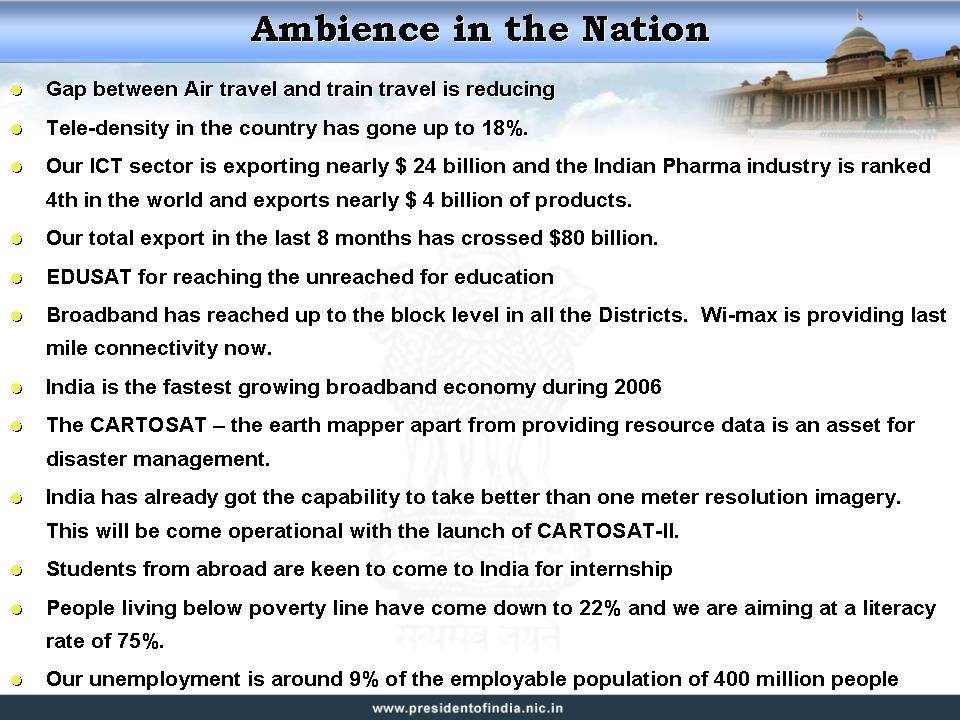

Ambience in 2020
We expect the people below poverty line to come to near zero and our literacy must be nearly 100%. Human Development Index of India will be around 50. Every Indian will have either a university degree or quality training with employable vocational skill. E-governance would be in position for all G2G and G2C transactions making the governance system transparent. Tele-density will reach over 75%. All our villages will be electrified. The interlinking of the rivers and water bodies will result in equitable distribution of water in irrigation, drinking and navigation and there will be no shortage of water. India would have realized energy security and will be working towards energy independence. Sanitary facility will reach every home. We will be using more of renewable energy such as solar energy, wind power and thorium based nuclear energy and adding less to the pollution. Through venture capital system and entrepreneurial training both in schools and colleges, we will have more enterprises leading to large number of employment generators rather than employment seekers. A pro-active healthcare system in place will provide quality healthcare to all the people of the country including those living in remote areas at an affordable cost through innovative schemes such as Yeshasvini and BR Hills scheme being practiced in Karnataka. All meritorious children will have an opportunity to take up the courses of their choice in higher education. I am sure; you will all see prosperity and plenty in the country which will replace scarcity and control.
In this changed scenario, the role of IB has become even more emphatic and important. Our efforts to grow as an economic super power are hindered very often by the violence promulgated by some misguided elements. Such in equilibrium in the society may impact on our economy is becoming an area of great concern.
Our intelligence and security agencies generally work away from limelight. Their successes and sacrifices always go unsung while their failures make the news. I congratulate the thousands of intelligence, security and police personnel, who work tirelessly, like our Armed Forces guarding the border, to safeguard our polity, the economy and the pride of the nation. As a tribute to this community, I have chosen to talk today on the topic ?Dynamics of Intelligence Missions?.
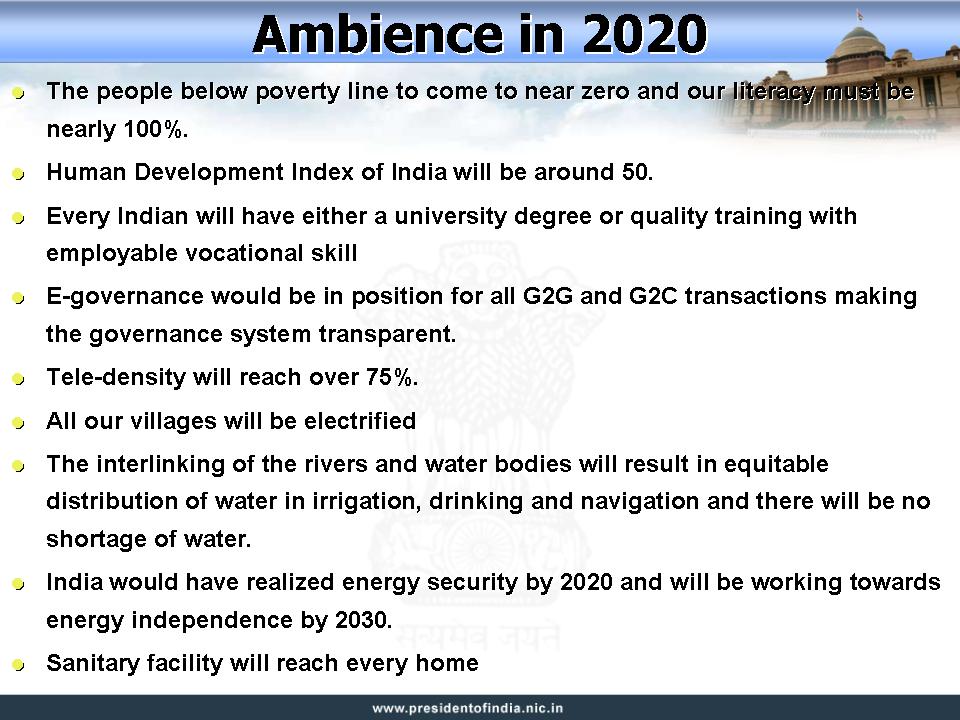

Origins of Life
Ancient human history has been revealed beautifully by Paleoanthropology. Life originated 600 million years ago and continental drift occurred 200 million years ago creating five continents. Mammals evolved 140 million years ago, Hominids that is the human type, evolved 26 million years ago but modern man only arrived on the scene some 200,000 years ago. He migrated and colonized the world only in the last 50,000 years. The spoken language is some 10,000 years old while writing evolved only a few thousand years ago. All this phenomenal progress has been achieved only within the short span of 200 to 400 generations that is in just 10,000 to 5,000 years. So far human society, from origin until now has always been at war within and between groups and has led to two World Wars. Presently, terrorism and low intensity warfare are affecting many parts of the world.
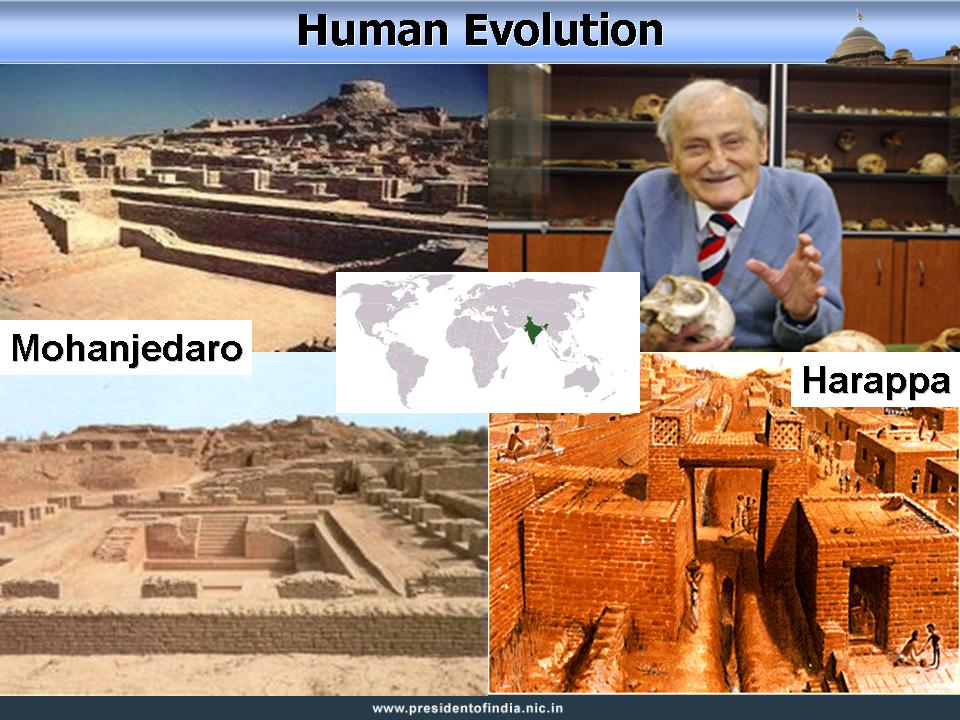

Code of conduct
In the early days of mankind, till the mid-sixties, the conflict between nations and even between tribes was settled by ?conventional wars? which had their own code of conduct. In the great war of Mahabharat, for example, they had a distinctive adherence to the order that they will not fight after sunset and also would not inflict collateral damages by killing the innocents. That was a society that was enlightened, prosperous and generous. Over the period of time, the growth of the society compromised the factors of enlightenment and prosperity and an entirely asymmetric society both in terms of economic development and religious alignments has emerged. This has changed the phase of the war and the war has become one of low intensity over a prolonged period with no concern for the killing of the innocents. In this new world, the dividing line between protection of the nation against external threats and internal threats has become very thin. This calls for an extraordinary level of co-ordination between the Armed Forces, intelligence agencies and the local police.
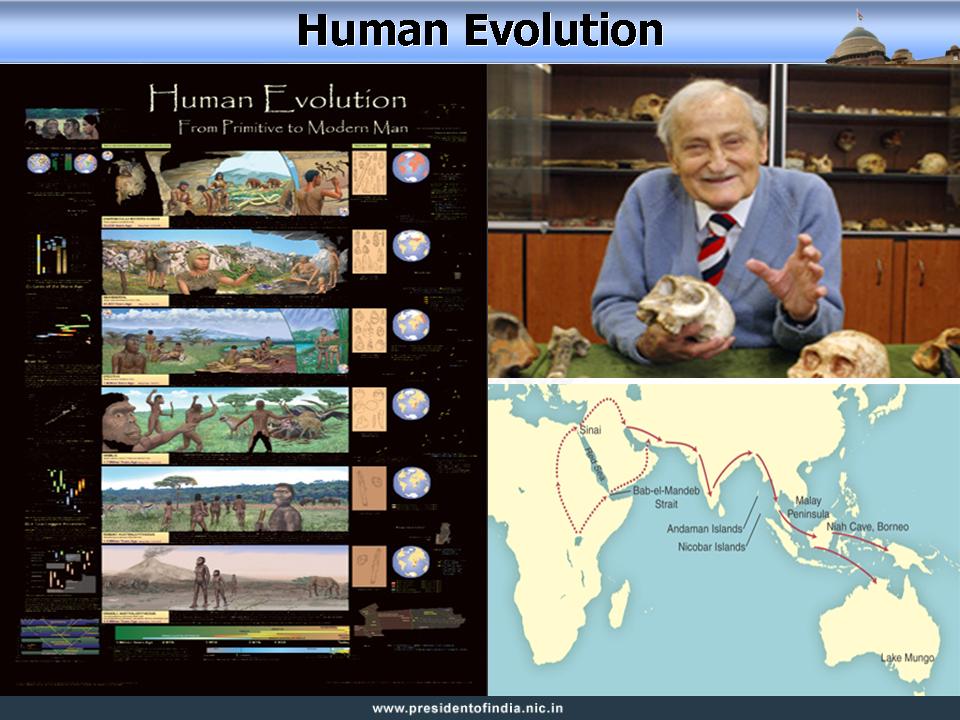

Comprehensive National Security
Peaceful and harmonious conditions in all parts of the country are essential for people to cooperate with one another for accelerated national growth. However, there are challenges to peace from across our geographical borders, from terrorism and violence, and from scarcities created by rapidly depleting natural resources. These dynamic challenges call for special measures to ensure a comprehensive, integrated system of security which has two major components: territorial security, and internal security.
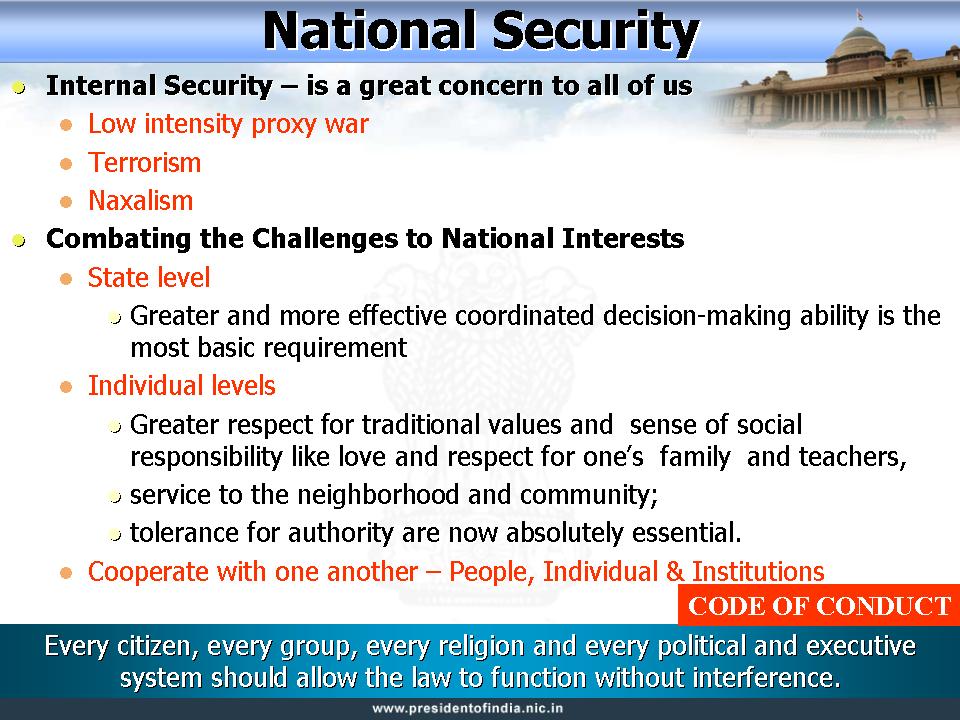
Territorial Security: Our nation and Armed Forces are well prepared to protect our territorial security. They are continuously being strengthened to deal with new forms of warfare.
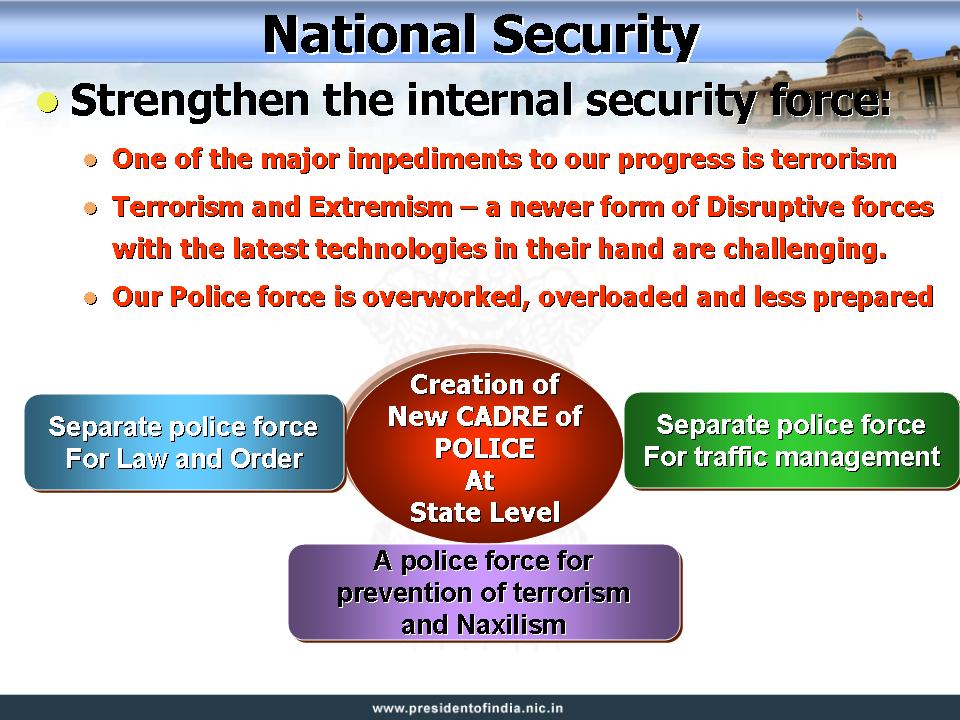
Internal Security: Let me now come to an important aspect of security that is drawing the attention of the entire country and the world. The constant threat of low intensity proxy war and terrorism has become a disturbing feature of national life. This constitutes the new face of war. Dear friends, this matter is of great concern to all of us. Therefore, I propose to share my thoughts with you on how we can face this challenge and resolve to eradicate this threat.
Combating Challenges to National Interests: At the State level, greater and more effective coordinated decision-making ability is the most basic requirement. At individual levels, greater respect for traditional values and sense of social responsibility like love and respect for one?s family and teachers, service to the neighborhood and community; tolerance for authority are now absolutely essential. Above all, we as people, individuals and especially institutions, require increased ability to cooperate with one another, improving thereby our work and personal relationships. While we have the basic structure in the form of law, police cadres, intelligence agencies and judicial system, we need to reinforce them with required updates with a code of conduct. Every citizen, every group, every religion and every political and executive system should allow the law to function without interference. To combat the challenges, I would like to discuss on economic security through development with peace and citizens security.
Economic security: Accelerated development has to be integrated with peace missions. Such missions will have four major components namely: economic zone near international borders and Line of Control, social development in difficult areas, national level movement to eliminate terrorism and citizen security.
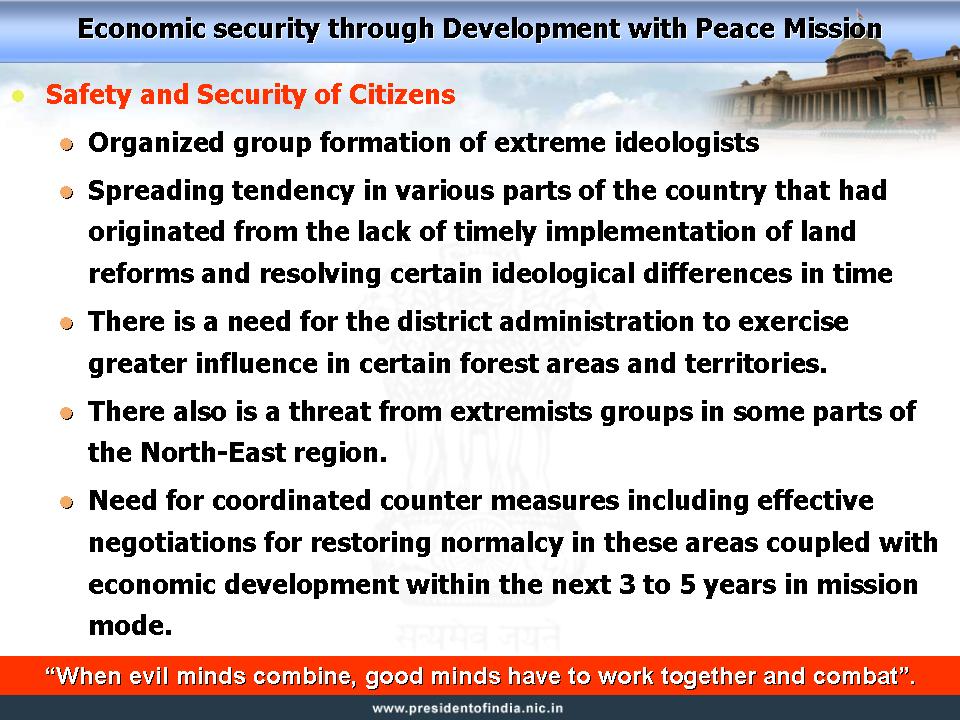
Citizens Security: Dear friends, now I would like to discuss only a very important aspect of how we can provide a sense of security for our citizens. The organized group formation of extreme ideologists and its spreading tendency in various parts of the country that had originated from the lack of timely implementation of land reforms and resolving certain ideological differences in time. Also, during my visit to certain States, I found that there is a need for the district administration to exercise greater influence in certain forest areas and territories.
There also is a threat from extremists groups in some parts of the North-East region. This points to the immediate need for coordinated counter measures including effective negotiations for restoring normalcy in these areas coupled with economic development within the next 3 to 5 years in mission mode.
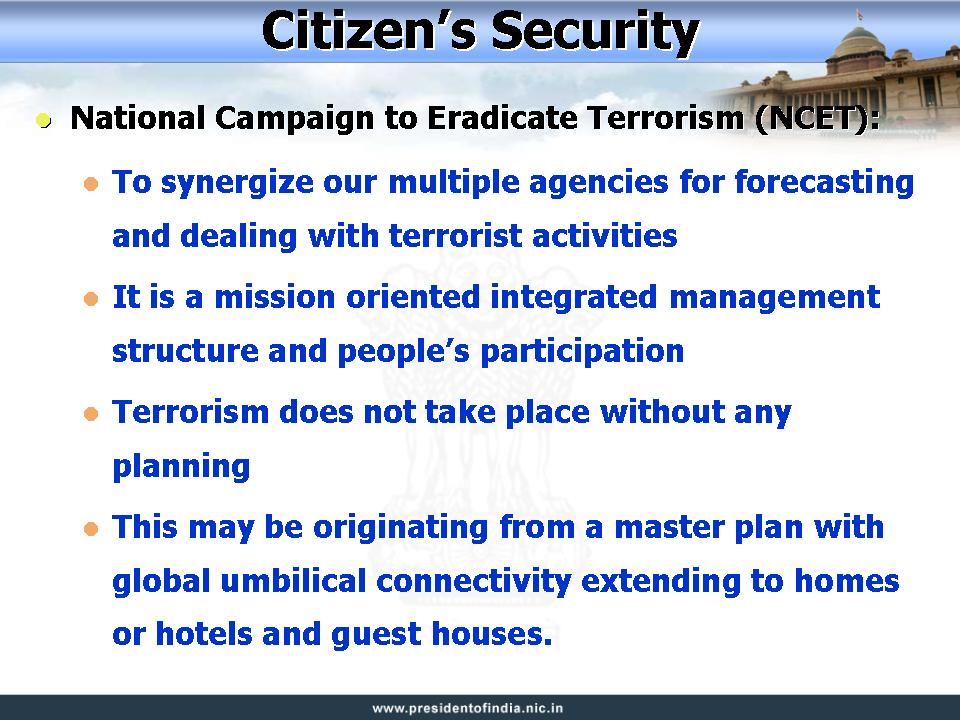
Acts of mindless violence have been taking place in the country for more than two decades and this phenomenon is continuously increasing. My Government, the Members of Parliament and State Legislatures are quite concerned about this and are considering how to address these issues of citizen?s security for formulating a national approach to eradicate terrorism in all its forms. This is an issue of national concern. We should transcend individual differences of opinion and address it with a sense of unity. This is the need of the hour. Let me give a plan of action.
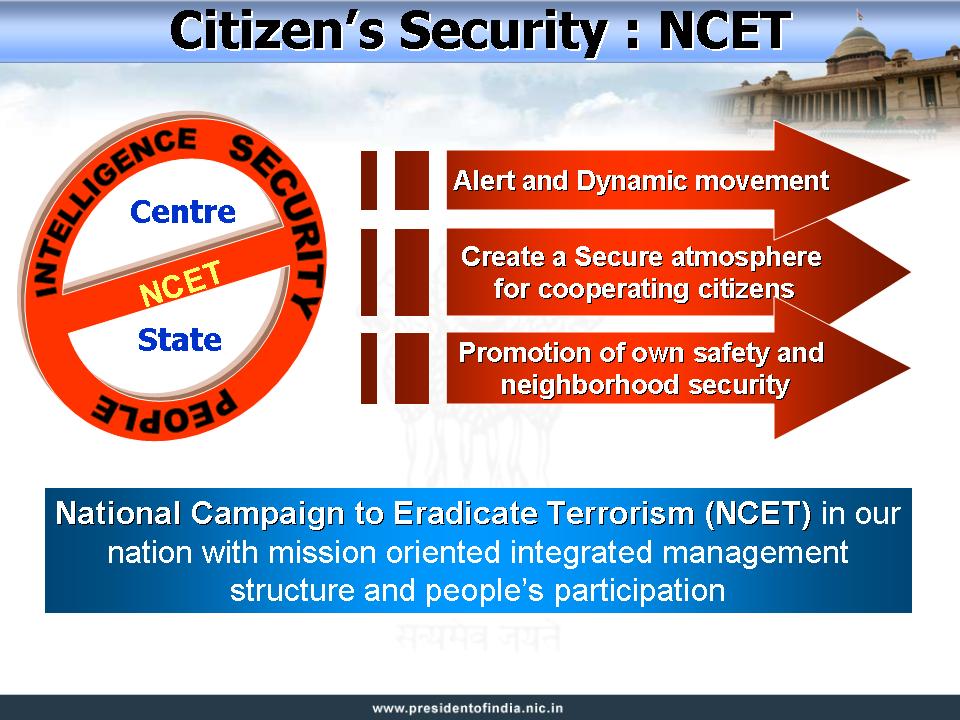

National Campaign to Eradicate Terrorism (NCET) for citizens security
I believe the time has come, to synergise our multiple agencies for forecasting and dealing with terrorist activities. We need to evolve a National Campaign to Eradicate Terrorism in our nation with mission oriented integrated management structure and people?s participation. It has been recognized that terrorism does not take place without any planning. This may be originating from a master plan with global umbilical connectivity extending to homes or hotels and guest houses.
NCET will facilitate working together of the intelligence and security machinery both at the State and the Central level to achieve the desired objectives. The NCET will be an alert and dynamic movement which would prevent hotels and homes being used as a shelter by terrorists and extremists. We have to create a secure atmosphere where citizens who wish to co-operate in the peace mission must themselves feel secure. Then citizens can participate in the important function of promoting their own safety and the security of their neighbourhood. This challenge is particularly acute in areas where there is floating population in transition through residential areas, hotels and other similar places that could unknowingly be used for wrong purposes.
The State may consider introduction of National ID Cards and implement the National e-governance GRID for all Government to Government, Government to Citizens, Business to Business and Business to Citizen transactions within two years time. It is important to realize the introduction of the National ID card is itself will be a boon for the intelligence agencies because this will help to control the dynamics. It is essential to create special monitoring methodology for unusual and abnormal banking transactions.
Today, with the introduction of computerized banking and computerized communication systems, the world of data mining is very advanced to detect such anomalies in real time. The judiciary must consider the creation of a fast track judicial process for settling terrorism related cases.
While the nation is growing economically, the great challenge it will face is to ensure that the growth is uniform and across all sections of the society. If there is large scale unevenness, the economic, ethnic, religious, geographic and digital divides assume mountainous proportion and they would work counter to the nation?s vision of economic prosperity.

Dynamic Intelligence System for 21st Century
Explosive growth in communication has made networking of terrorist for a perceived act of violence very easy. This technology explosion has been to the great disadvantage for the intelligence agencies. But, there is a silver lining. If the intelligence agencies are alert and committed, they could bring in the awesome power of the same technology to counter the terrorists and decimate them. They can use the technology to monitor and counter the communication. They can also use the same technology to communicate with the public and other stakeholders to educate them to work in unison with the State to identify potential threats even before they start brewing. They can communicate with the terrorist to reform them and bring them back to normal life which they left due to temporary aberration.
Convergence of communication devices: Today?s cell phone epitomizes the convergence of many applications. For example, the cell phone today can be used as a simple phone for voice, has the storage for address book, it is camera, it can be used for exchanging and viewing video, it can be used to browse the web and download data and email, it is multilingual, it can be used as an MP3 music player and as a radio and above all it can be used as an authentication mechanism for mobile e-commerce and banking. It can understand speech and record conversations, text and video. This convergent device is becoming smarter by the day and soon would be able to understand even gestures and would present a natural interface to interact almost in a human like fashion. Monitoring such a converged medium of communication that threatens to doubles in capacity every year is a great challenge for the intelligence community. The fact that this has to be done without intruding into the privacy of the individual is a greatest challenge.
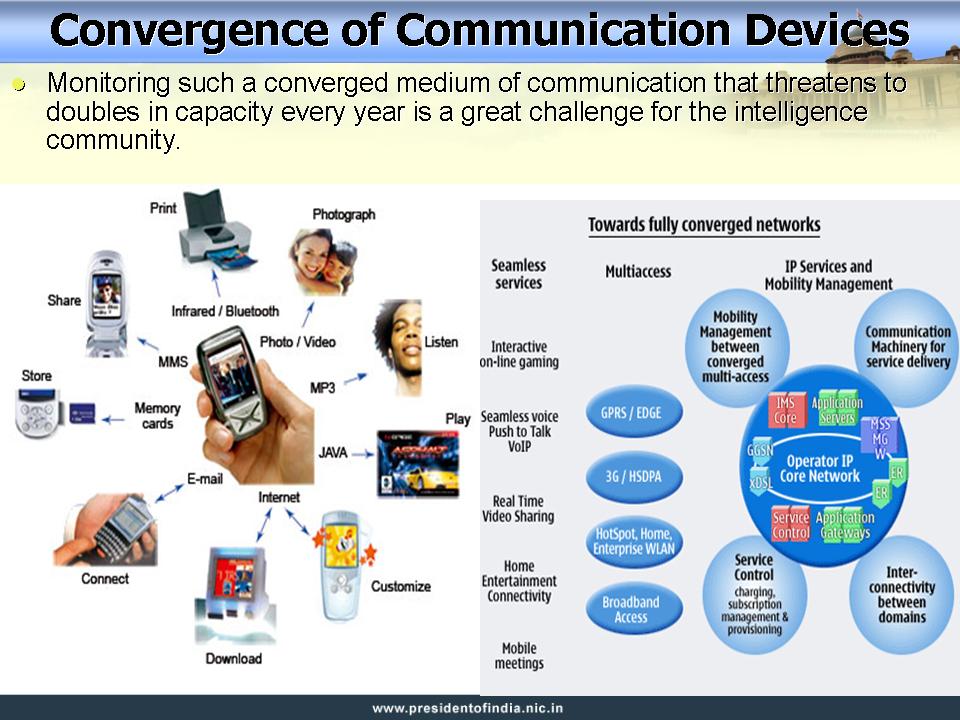
The networks are also becoming smarter and this has made the distinction between various service providers thin. For example, the cable TV operators offer telephony and internet services and the Internet service providers are making forays into the world of entertainment. These technological advances have enabled the anti-social elements to use the technology more intelligently for subversive activities. Just like technology, where technology is used to create new technology, they divide such as ethnic and economic divides, work towards furthering the divide.

Cyber terrorism
In the recent times with the growth of internet, criminals have also started using technology tools. In fact the concept of cyber terrorism has emerged during the last few years. Cyber attack in the cyber space has brought in untold problems to the banking system, business interests and even private individuals. In order to control cyber terrorism, the related rules, regulations, policies and law have to be evolved so as to make life difficult for the cyber terrorist without causing undue harassment to the genuine user. Intelligence agencies like IB should equip themselves with all the cyber security tool such as internet monitoring, defensive analysis, sniping and hacking analysis and emergency response method to take fast real time action against possible attacks. Intelligence agencies are using VHF walkie-talkie exposing themselves by being monitored by motivated agencies. Therefore, intelligence agencies should equip themselves with the latest digital encryption systems instead of using conventional analog scramblers. It is also necessary to make all the rank and file belonging to the intelligence agencies to become cyber literate so that they can take real time action in the field.
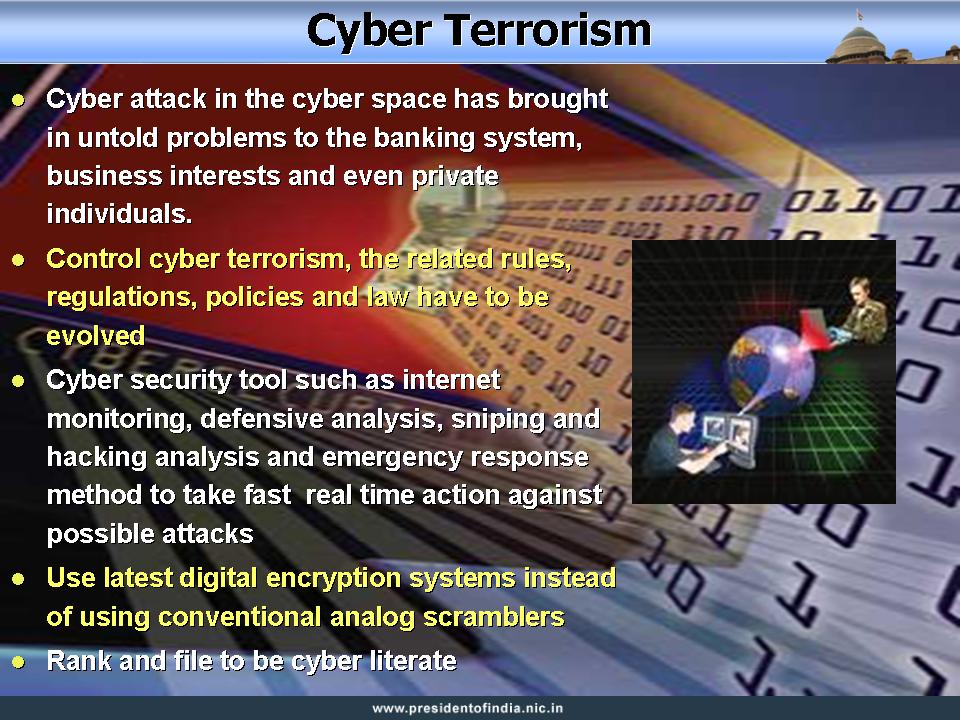
Future of technology: By 2030, every human being, every object ever traded or created would have unique ID-RFID. This will make the tracking of individuals and understanding their anomalous and suspicious behaviour as pre-curser to an act of violence or an economic offence. This will, however, need the Government to be continuously alert to technological changes world over and become a centre stage of creation and assimilation of such technologies.
Intelligent Explosive Detection: Many of the attack by the terrorists had been through the use of hidden explosives. The world had made tremendous advances in spectroscopy both in electronic and microwave frequencies as well as the infra-red and optical frequencies. However, these frequencies have not proven to be adequate to detect explosives such RDX hidden inside the box or inside the vehicle. The gap between electronic and optical frequencies called the terra-hertz gap was not explored earlier because of the lack of technologies for generation and detection of these frequencies. Today, this gap called the terra-hertz gap is promising to be a possible technology for detecting hidden explosives in many cases. However, much scientific research has to be done to make this technology a usable one at an affordable cost.
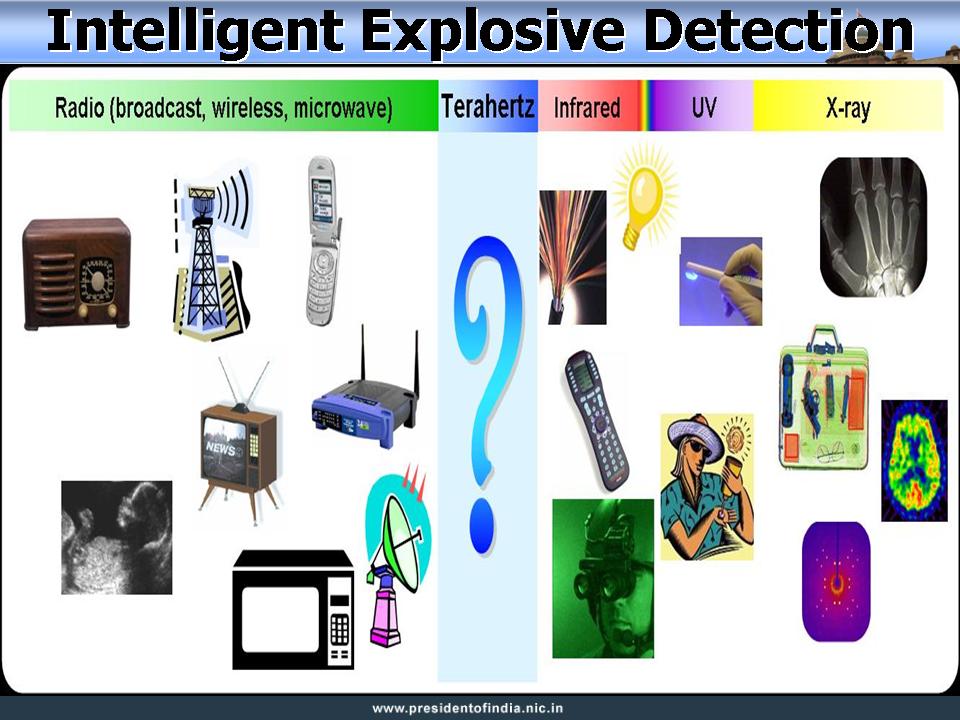
Surveillance technologies: The optical and infrared cameras have revolutionized their applications to surveillance. They become very high end resolution and speed, born digital and very small size and cost. It has become possible today to deploy a few thousands of them in public places and make them work in a cooperative way to detect both static and dynamic environments. The static detection is used for authentication based on facial images and even iris. The dynamic detection can identify man and material movements. The image processing technology has improved to a point where the collection of cameras can be used to identify anomalous events that act as pre-cursor or a warning bell for an impending terrorist attacks.
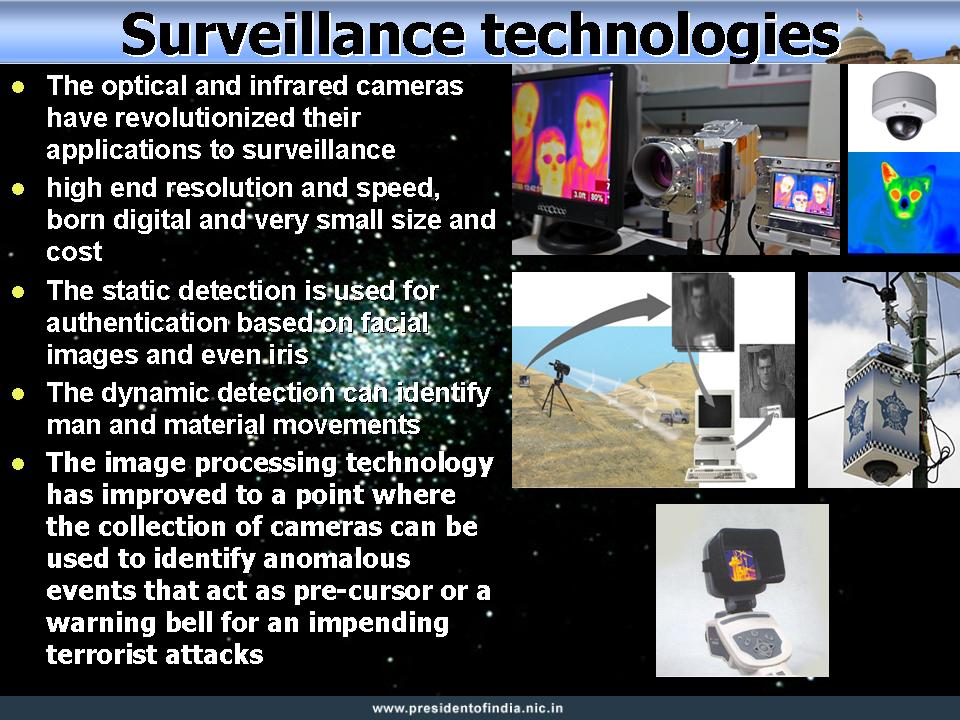
Sensor networks: Traditionally computers and communication are understood to have merged and silicon was the binding material. Silicon was considered till recently as a bad element for sensing and also for generating Photovoltaic power. But recent developments have improved the efficiency of silicon in both these cases and silicon has also become integrable with other efficient sensors and power generators. This has given birth to the convergence of sensing, processing and communicating on a single energy efficient device. A large number of them could be now deployed as the sensors of the environment for detecting radio signals and chemical & biological traces. The individual sensors communicate with each other through an adhoc and self-organizing wireless networks. The radio signals picked up by the individual sensors can be gathered periodically by a micro light remotely piloted vehicle which is no bigger than a dove. The chemical and biological tracer detection can be used for detecting chemical and biological warfare and catastrophe. The wireless sensor networks are likely to form a very integral and intelligent sensing system for internal security and intelligence community. The challenge of integrating multiple measurements coming from a variety of sensors and even integrating information coming from many sources could be met only by advancing the frontiers of research and development in the area of ?sensor fusion?. Mastering this technology and fostering it to grow should be the major goal of IB.
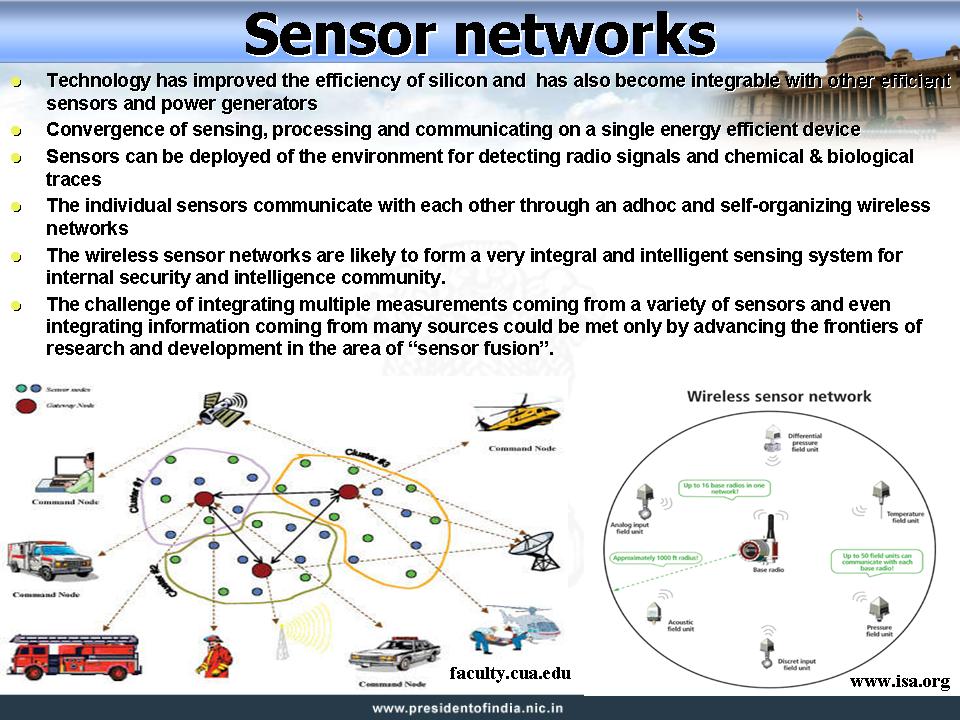
Social networks: Few years back an experiment was tried out by the scientific community about what today we know as social networks. A letter to a doctor in Boston was posted without proper address but only with name and Boston. It was sent to the close friends of the originator, with a request to his friends saying that you pass it on to your close friends who may know this doctor; with this kind of idea the chain was started. On an average it reached the destination within six links. Though the world of communication is very big and millions and millions of phones are connected, millions and millions of people send email; we find that there is a structure in all of these. Whom did you contact is more important than what did you contact him for. This concept of social networks is the central to this, which is communication. So the theme behind this is starting from any arbitrary person, we can identify the offending group of people, say smugglers, terrorists, money launderers within a few links. The data mining and network monitoring technology, has grown so much that even the millions and millions of emails and telephones originating every day can be logged, analyzed and conclusions drawn.
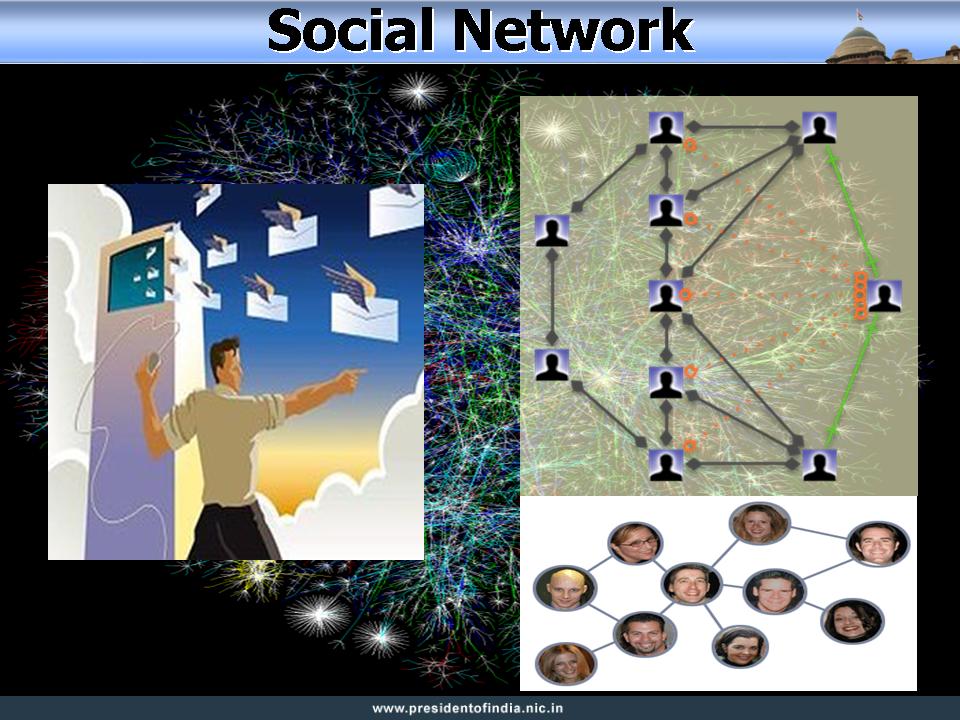
Partnership: The role of NASA in the United States and the DRDO and Atomic Energy in India have been epitomized by strong academic interaction to create a technology reservoir for solving problems in the defence of the nation and later on taking them to the society for their prosperity. With the rapidly changing phase of technology, intelligence agencies are required to work in close partnership with academia, R & D institutions and the industry. For example, material technology has been applied for the development of a cost effective cardiac stent and the carbon-carbon technology has been applied for the fabrication of low cost, light weight Floor Reaction Orthosis calipers. Similarly, partnership with these institutions will provide a cost effective solution for intelligence agencies to beat the technological advancement. With all these advancements, I am visualizing a typical scenario well before the year 2020 in our country.
Typical scenario: I visualize an election scenario in 2015, where a candidate files his nomination from a particular constituency. Immediately the election officer verifies his/her authenticity from the national citizen ID database through multifactor authentication, through a multipurpose Citizen ID card. His education credentials come from the school or university records. His track record of employment comes from various employers with whom he had worked. His income and wealth resources come from the income-tax department, and other sources. His property record comes from the registration of land authority across the country. His credit history comes form various credit institutions like banks. His/her civic consciousness and citizenship behaviour comes from the police crime record. His legal track records come from the judicial system.
All the details arrive at the computer terminal of the election officer within a few seconds automatically by the act of e-Governance software agents which crawls across the various state and central government web services directories through the network GRID and collects the information automatically and presents the facts in real-time without any bias. Artificial intelligence software analyses his credentials and gives a rating on how successful he will be as a politician. Election officer sitting at the remote block of the country decides on the spot and the election process starts. All the voters vote from their home through virtual polling booths. This will become a reality soon. IB should equipped to meet this challenge. In this scenario you need to establish an IB e- governance grid for G2G connectivity for IB offices across the nation with the nodal data centre at IB HQ in New Delhi. This should be interconnected with the other e-governance grid of the country as I described earlier.
In Rashtrapati Bhawan we have designed and implemented an e-Governance system to study all the management needs and determine the action requirements to be taken by Rashtrapati Bhavan and other agencies of government and the relevant institutions both public and private. We are in the process of establishing a total e-governance system with G2G and G2C connectivity. You may like to study.

Conclusion
Since I am in the midst of IB community, I would like to make the following suggestions:
(i) Upgrading personnel and equipment with state of art technology. Equipping IB with technology for counter intelligence, counter terrorist and counter insurgency operations.
(ii) Improved service conditions of IB personnel consistent with the job challenges, expertise, risks and life time commitment and incentives to ensure gap free intelligence collection that foresee events and lead to preventive actions.
(iii) Reducing turnaround time between collection, collation, dissemination of information to enable fast proactive action to avert a disaster.
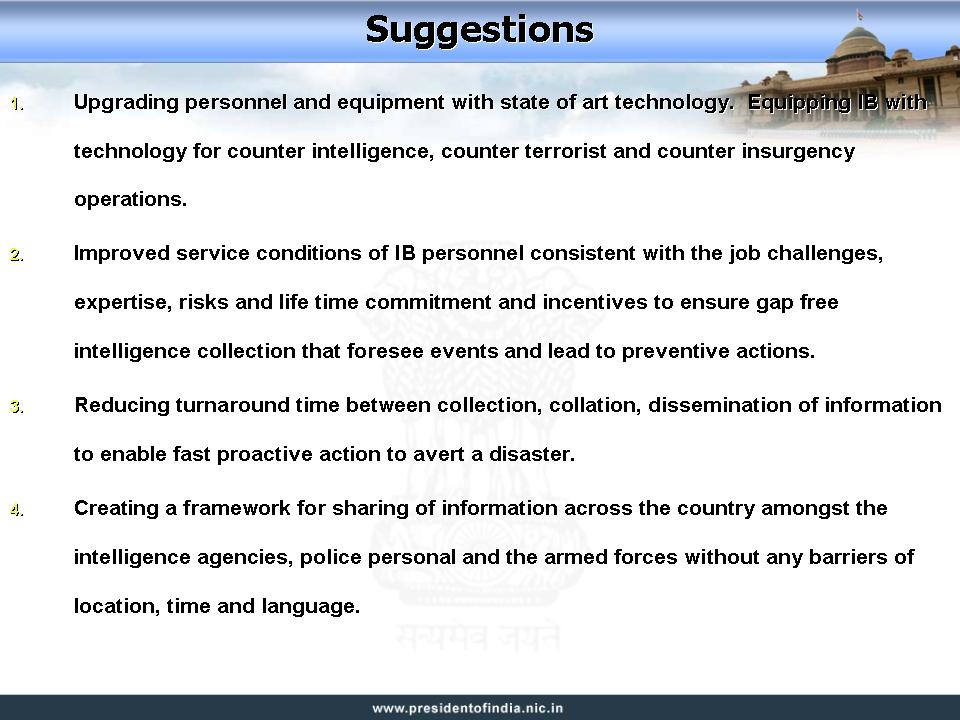
(iv) Creating a framework for sharing of information across the country amongst the intelligence agencies, police personal and the armed forces without any barriers of location, time and language.
(v) Forging a very close collaboration between academia, industry and the intelligence agencies for creating a state of the art capacity and technology building environment. The consortium should become also a fountainhead of newer technologies for the society that are offshoots of technology for the intelligence community.
(vi) Redefining the role of IB in the context of the technological, social and cultural challenges of the 21st century to make IB an effective instrument to prevent subversion and promote peaceful national development.
(vii) Intelligence Bureau must carry out a research on hundred cases where they have taken proactive action and averted a disaster and similarly 10 cases in which IB action has resulted in injury to the innocent individual or system. This study should be able to enable evolution of best practices for implementation by the agency as a whole.
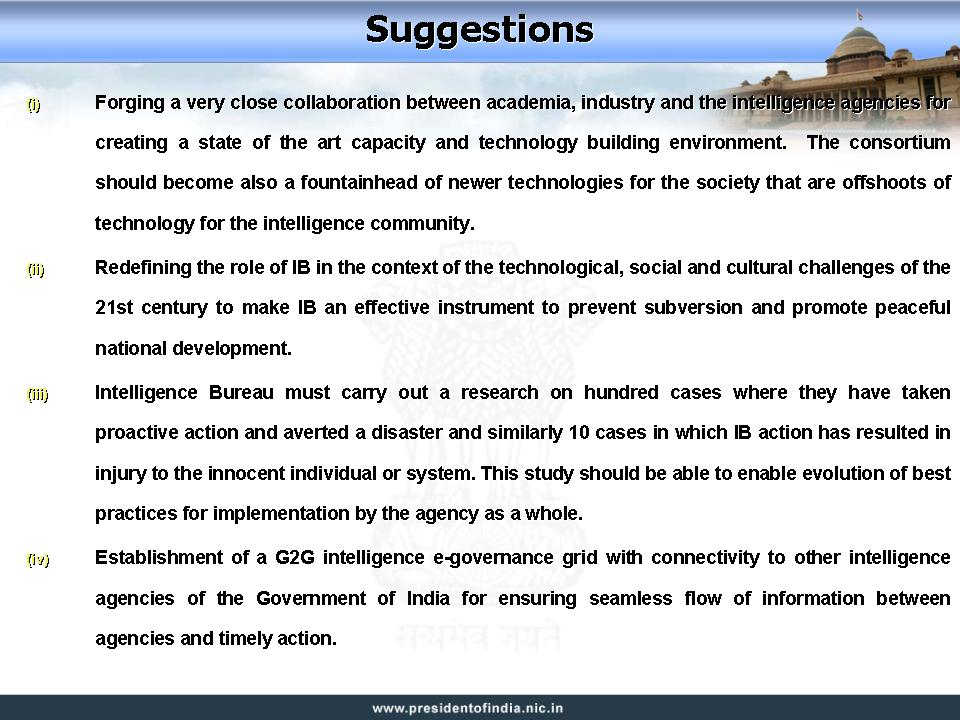
(viii) Establishment of a G2G intelligence e-governance grid with connectivity to other intelligence agencies of the Government of India for ensuring seamless flow of information between agencies and timely action.
My best wishes to all the participants of the 19th IB Centenary Endowment Lecture for success in their mission of providing pro-active action oriented information to promote safety of the individual, system and assets of the nation.
May God bless you.
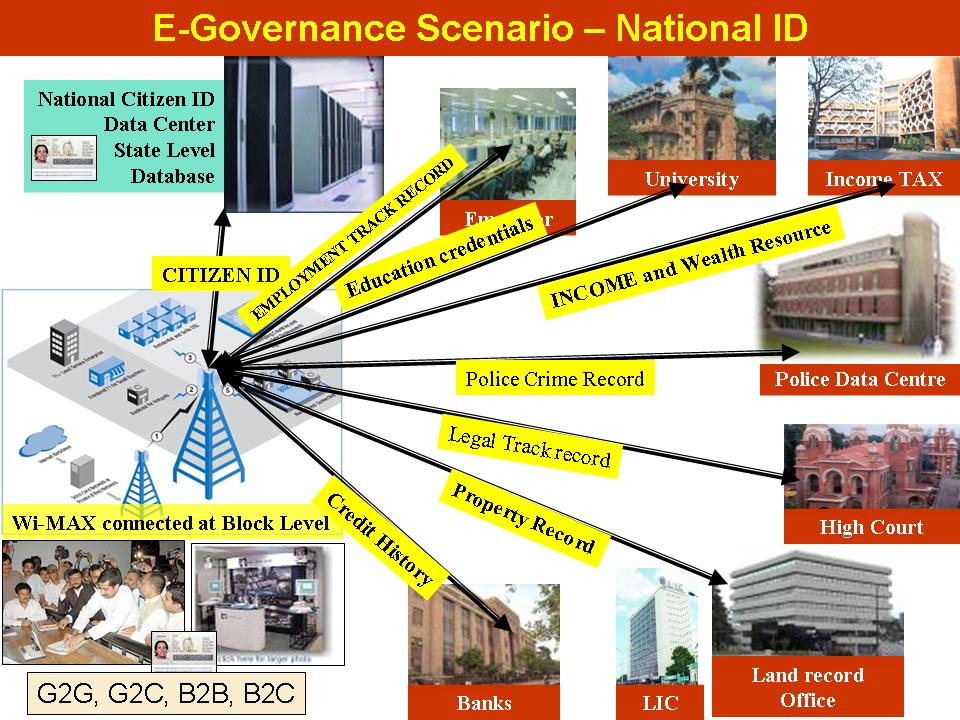
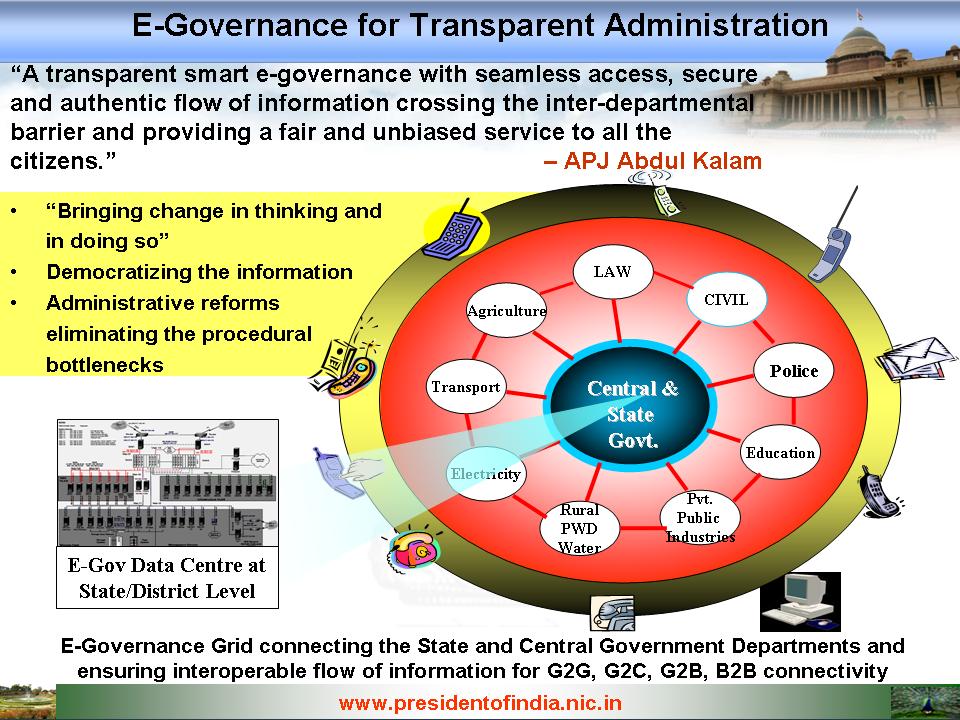
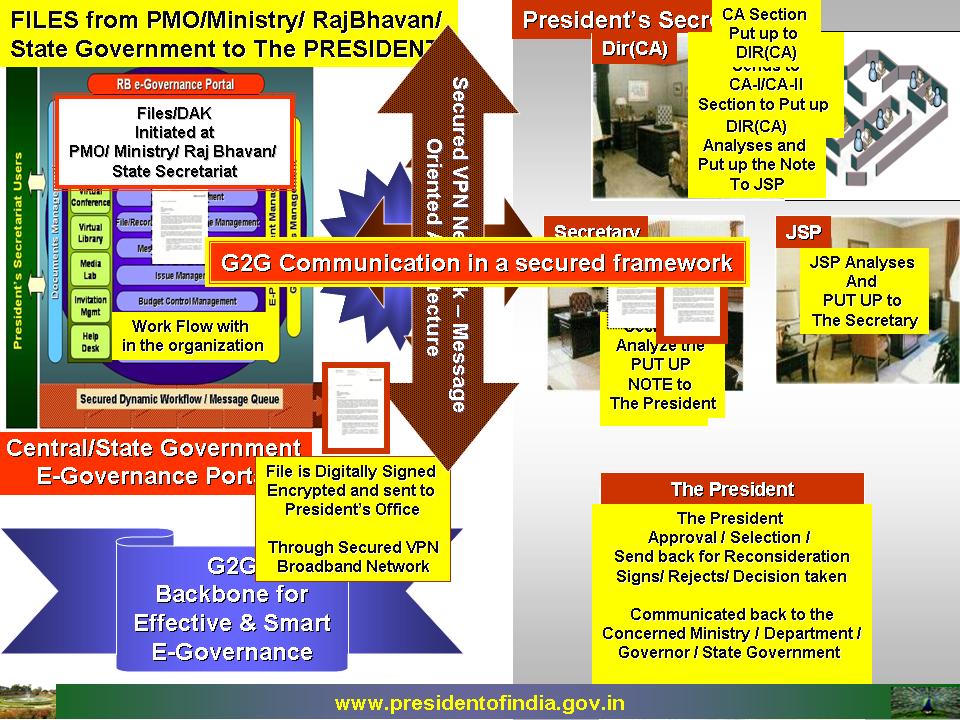
<<Back
|
|